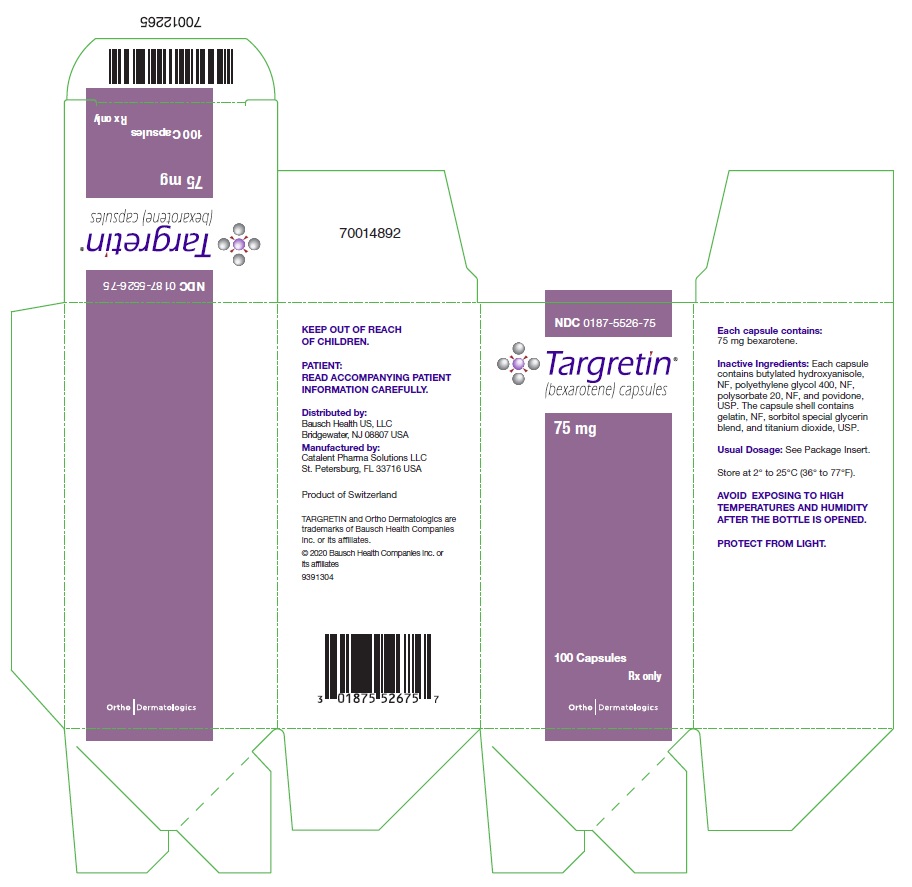Targretin
Generic name: bexarotene
Drug class: Miscellaneous antineoplastics
Medically reviewed by A Ras MD.
What is Targretin?
Targretin is a prescription medicine used to treat the skin problems that happen with a type of cancer called cutaneous T-cell lymphoma (CTCL) after treatment with at least one other type of medicine by mouth or injection, did not work or has stopped working.
It is not known if Targretin is safe and effective in children.
Description
TARGRETIN® (bexarotene) Capsules contain bexarotene, a member of a subclass of retinoids that selectively activate retinoid X receptors (RXRs). These retinoid receptors have biologic activity distinct from that of retinoic acid receptors (RARs).
The chemical name of bexarotene is 4-[1-(5,6,7,8-tetrahydro-3,5,5,8,8-pentamethyl-2-naphthalenyl)ethenyl]benzoic acid, and the structural formula is as follows:
Bexarotene is an off-white to white powder with a molecular weight of 348.48 and a molecular formula of C24H28O2. It is insoluble in water and slightly soluble in vegetable oils and ethanol, USP.
Each TARGRETIN capsule contains 75 mg of bexarotene for oral administration. It also contains the following inactive ingredients: butylated hydroxyanisole, NF, polyethylene glycol 400, NF, polysorbate 20, NF, and povidone, USP. The capsule shell contains gelatin, NF, sorbitol special glycerin blend, and titanium dioxide, USP.
Mechanism of Action
Bexarotene selectively binds and activates retinoid X receptor subtypes (RXRα, RXRß, RXRγ). RXRs can form heterodimers with various receptor partners such as retinoic acid receptors (RARs), vitamin D receptor, thyroid receptor, and peroxisome proliferator activator receptors (PPARs). Once activated, these receptors function as transcription factors that regulate the expression of genes that control cellular differentiation and proliferation. Bexarotene inhibits the growth in vitro of some tumor cell lines of hematopoietic and squamous cell origin. It also induces tumor regression in vivo in some animal models. The exact mechanism of action of bexarotene in the treatment of cutaneous T-cell lymphoma (CTCL) is unknown.
What is the most important information I should know about Targretin?
For females who can become pregnant:
- You should avoid becoming pregnant during treatment with Targretin.
- Do not take Targretin if you are pregnant or plan to become pregnant.
- Your healthcare provider will do a pregnancy test, within 1 week before you start Targretin, and each month during treatment with Targretin to make sure that you are not pregnant.
- You must use two effective forms of birth control together starting 1 month before you begin treatment with Targretin, during treatment, and for 1 month after stopping Targretin. Birth control pills (oral contraceptives) and other hormonal forms of birth control may not be effective if used with Targretin. At least one of the forms of birth control that you choose should not contain hormones. Talk to your healthcare provider about what forms of birth control may be right for you during treatment with Targretin.
- You should start taking Targretin on the second or third day of a normal menstrual period. Follow your healthcare provider’s instructions about when to start Targretin.
- Call your healthcare provider right away, if you become pregnant or think that you are pregnant during treatment with Targretin, and for 1 month after you stop taking Targretin.
For males:
- You must use a condom with female partners who are pregnant, might be pregnant, or who are able to become pregnant, during treatment with Targretin and for at least 1 month after your last dose.
Who should not take Targretin?
Do not take Targretin:
- if you are pregnant or plan to become pregnant. See “What is the most important information I should know about Targretin?”
- if you are allergic to bexarotene or any of the ingredients in Targretin. See the end of this leaflet for a complete list of ingredients in Targretin.
What should I tell my healthcare provider before taking Targretin?
Before taking Targretin, tell your healthcare provider about all of your medical conditions, including if you:
- have or have had problems with your pancreas, including pancreatitis
- have or have had gallbladder problems
- have or have had liver problems
- have thyroid problems
- have diabetes
- have high levels of fats (lipids) called cholesterol or triglycerides in your blood
- have cataracts or a history of cataracts
- drink alcohol
- are pregnant, plan to become pregnant, or think you may be pregnant. See “What is the most important information I should know about Targretin?”
- are breastfeeding or plan to breastfeed. It is not known if Targretin passes into your breast milk. You should not breastfeed during treatment with Targretin. Talk to your healthcare provider about the best way to feed your baby during treatment with Targretin.
Tell your healthcare provider about all of the medicines you take, including prescription and over-the-counter medicines, vitamins, and herbal supplements. Using Targretin with certain other medicines can affect each other.
How should I take Targretin?
- Take Targretin exactly as your healthcare provider tells you.
- Your healthcare provider will tell you how many Targretin capsules to take each day. Your healthcare provider may change your daily dose of Targretin as needed to treat your CTCL or if you get certain side effects. You should not change your dose unless your healthcare provider tells you to.
Take your dose of Targretin one time a day with a meal. Your healthcare provider will do blood tests before you start Targretin and during treatment to check for side effects.
What should I avoid while taking Targretin?
- Limit your exposure to sunlight and artificial types of sunlight. Targretin can make your skin more sensitive to sunlight and you can get sunburn.
- Limit the amount of vitamin A that you take during treatment with Targretin. Large doses of vitamin A may cause side effects that are similar to side effects that can happen in people who take Targretin.
What are the possible side effects of Targretin?
Targretin can cause serious side effects, including:
- See “What is the most important information I should know about Targretin?”
- Increased levels of fats (lipids) called cholesterol or triglycerides, in your blood are common with Targretin, but can also be serious.Your healthcare provider may prescribe you medicines to treat high cholesterol or triglycerides levels, reduce your dose, temporarily stop treatment or completely stop treatment with Targretin if you have this problem.
- Inflammation of the pancreas (acute pancreatitis).Targretin can sometimes cause pancreatitis that comes on suddenly (acute), and that can lead to death. Your risk of developing acute pancreatitis may be greater if you:
- have had pancreatitis in the past
- high levels of fats in your blood that are not controlled
- drink large amounts of alcohol
- have gallbladder problems
- have diabetes that is not controlled
- take certain medicines that can increase the amount of triglycerides in your blood
- take medicines that can harm your pancreasTell your healthcare provider rightaway if you develop signs or symptoms of pancreatitis during treatment with Targretin, including:
- nausea that will not go away
- vomiting
- stomach-area (abdominal) or back pain
- Liver problems, including liver failure. Targretin can cause increased liver function blood test results, or liver problems that can lead to death.
- Thyroid problems (hypothyroidism) are common with Targretin. Your healthcare provider may prescribe thyroid hormone treatment for you if needed.
- Low white blood cell count is common with Targretin, but may sometimes be severe.
- New or worse cataracts.Tell your healthcare provider about any changes in your vision during treatment with Targretin. You may need to have an eye examination.
- Risk of low blood sugar in people who have diabetes. Targretin can interact with certain medicines used to treat diabetes, such as insulin, sulfonylurea medicines, and thiazolinedione medicines. If you have diabetes, talk to your healthcare provider about your diabetes medicines and your risk for low blood sugar if you take Targretin.
The most common side effects of Targretin include:
- headache
- asthenia
- rash
- nausea
- infection
- stomach-area (abdomen) pain
- swelling of your hands, arms, feet or legs
- dry skin
These are not all the possible side effects of Targretin. Call your doctor for medical advice about side effects. You may report side effects to FDA at 1-800-FDA-1088.
General information about the safe and effective use of Targretin
Medicines are sometimes prescribed for purposes other than those listed in a Patient Information leaflet. Do not use Targretin for a condition for which it was not prescribed. Do not give Targretin to other people, even if they have the same symptoms that you have. It may harm them. You can ask your pharmacist or healthcare provider for information about Targretin that is written for health professionals.
How should I store Targretin?
- Store Targretin between 36° to 77°F (2° to 25°C).
- Store the Targretin bottle away from light, heat, and humidity.
- The capsules should not be taken after the expiration date printed on the bottle.
Keep Targretin and all medicines out of the reach of children.
Label
PACKAGE/LABEL PRINCIPAL DISPLAY PANEL – TARGRETIN – 75 MG CARTON
- NDC 0187-5526-75
- Targretin®
(bexarotene) capsules - 75 mg
- 100 Capsules
- Rx Only
- Bausch Health Companies


What are the ingredients in Targretin?
Active ingredient: bexarotene
Inactive ingredients: butylated hydroxyanisole, polyethylene glycol 400, polysorbate 20, and povidone. The capsule shell contains gelatin, sorbitol special-glycerin blend, and titanium dioxide.
SRC: NLM .
